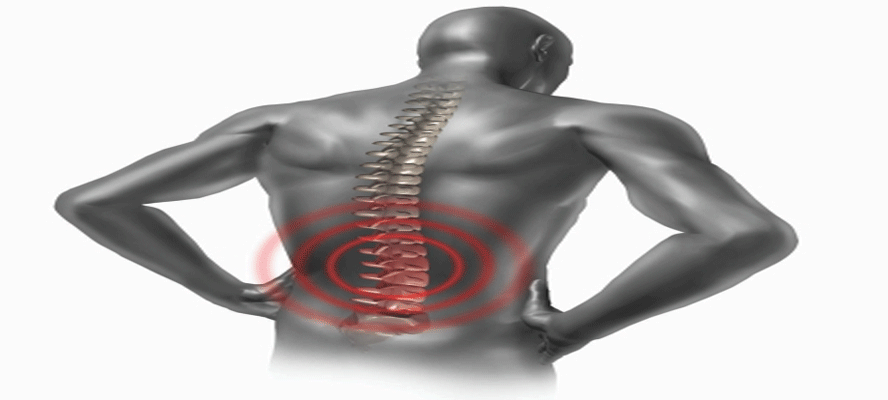Among top day-to-day health concerns, back pain is one of the most known and commonly experienced
condition. Long hours of sitting in the office, frequent leaning down to pick up things, lifting heavy bags or
other items, and many such hip twisting-turning activities and others tend to make you experience back pain
every now and then Moreover, this back pain which at times can be mild while at other times excruciating can make
you seek refuge in some or other form of pacifiers like medicines, hot bag, ointments, etc. Even studies suggest
that mostly every adult is bound to seek medical attention for back pain at some point in their life! As we
mentioned, there could be numerous reasons behind the back pain you may experience with majority of them being
contributed by some or the other way of mechanical stress or even sudden trauma to your back. But beware, not
always it could be some mechanical stress that affects and gives you back pain. Because there lies one serious
condition in which the back pain may also signal... Ankylosing spondylitis.
What is spondylitis?
Ankylosing spondylitis (AS) is a chronic inflammatory disease that is found to affect the sacroiliac
joints and the spine. It is thus not any normal back pain one may experience due to physical trauma to
the spine. Rather, it is a kind of rheumatoid Arthritis, which causes either growth or even fusing of
the vertebrae, resulting into a rigid spine. The fusing of the spine thus manifests itself in the form
of severe pain and stiffness right in the neck to the lower back of the affected individual. Such mild
to prominent changes in the spine may give rise to 'stooped-over' posture making even simple movements
like sitting or walking painful for the individual.
Etiology
The exact cause of spondylitis is unknown however, geneties
and heredity is found to play a significant role in this
condition. The alleles of Major histocompatibility
complex (MHC), particularly of HLA-B27 is known to
account for the major portion of being a causative
factor towards spondylitis. Other MHC alleles that may also
contribute towards spondylitis include HLA-B60, HLA-DR1.
HLA-B27 is also found to be an important marker
which can vary based on the race and ethnicity
of an individuals or groups.
Who is affected by Ankylosing Spondylitis?
Being a disorder primarily affecting the axial skeleton, spondylitis is found to be prevalent in about 0.19 to
29 in a given population with a higher score on the male population than in
females. The estimated male
female ratio is as high as 5:1 with a mean age for its onset being between 15 to 35 years.'
Signs & Symptoms of Spondylitis
The course of spondylitis development differs greatly from individual to individual. While in some the onset of symptoms
would start as early as at the age of 17, in others, the symptoms may appear in adulthood. Moreover, the symptoms
are generally found to appear within the age span of 17 to 45 years and in certain cases, even before 17 years.
Intermittent flare-ups of pain and stiffness in the spine are the common symptoms of spondylitis; however, the disease in
later stages can also affect other joints along with eyes and intestines. Advanced stages of spondylitis can also enuse
bone growth in the spine that ultimately fuse together reducing the mobility of an individual.
The initial symptoms of spondylitis include pain and stiffness in the lower back and buttocks which eventually increases over
the course of weeks to months. Usually a diffused or dull pain and discomfort is felt either on one side of the back
or alternate sides worsening in the mornings and during nights. The pain may subside with a warm shower or light
exercise, but only temporarily The individual may also suffer from general discomfort, mild rise in temperature and
loss of appetite. Though these initial symptoms of back pain may be similar in nature to one which are caused due to
long hours of sitting, lifting of heavy things, etc., it should be understood that spondylitis is not caused due to any
mechanical straining, but purely due to inflammation of the spine. Also, yet another aspect to be noted is that
the presentation of symptoms at its onset are different in males and females.
As the condition advances vigorously, the pain becomes chronic and is felt on both sides of the spine, This
will continue for a minimum of 3 months until the stiffness and pain gradually spread throughout the spine
reaching the neck area. The pain will eventually be felt in the ribs, shoulder blades gradually moving down
the hips, thighs and even heels. The chronie pain and stiffness in the back eventually poses danger of spinal
fusion thus rendering difficulty in mobility in an individual
Other spondylitis symptoms that the individual might experience would include fatigue which is mostly caused due to body's
energy spent in dealing with the increased inflammation. This could be coupled with anemia of mild to moderate
nature, overall contributing to tiredness. One may even experience fever and loss of appetite and in some cases,
may also develop lung and heart problems. Yet another group of individuals will experience the symptoms differently
with the onset of pain in peripheral joints like that of hip, ankle, elbow, heel or shoulder than in the lower back.
The peripheral joint pain is more common in juveniles suffering from spondylitis and is generally confused with other types
of arthritis.
spondylitis though affects the spine and other joints, is also
found to be associated with other conditions such as
ulcerative colitis (Crohn's Disease). Again, it is reported
that almost one third of people suffering from spondylitis are also
found to experience inflammation of the eyes (iritis). This
typical inflammation of the eyes is characterised by painful,
red and watery eyes. The individual also becomes sensitive to
bright light and may experience blurring of vision.
An individual suffering from spondylitis may also experience its effects on some of the ligaments
and tendons that are attached to the bones. Inflammation of these tendons (tendonitis) may
give rise to pain and stiffness in the areas surrounding and beneath the heel.
Diagnosis of Spondylitis
The diagnosis of spondylitis is usually found to get delayed till the later stages. This is mostly due to symptoms
experienced which are not specific to the condition in its initial stages. Diagnosis in its initial days is
however, based on various factors as mentioned below.
Physical Examination:
As the clinical signs are minimal
in the initial stages, physical examination, specifically of the musculoskeletal system is essential. This would
also include sacroiliac joint, spine and neck examination.
Other physical examination strategies would include
measurement of chest expansion during breathing. This is essentially done as in the later stages of the condition,
the spine becomes stiff affecting its mobility in all the planes including restriction of chest expansion.
Examination of motion of the hip, shoulder joints, presence of signs of enthesitis (inflammation of the
entheses - a site where the tendons/ligament enter the bone) are also carried out to achieve an early
diagnosis of spondylitis. Though important findings may be observed in enthesitis, they are majorly overlooked in juvenile AS
patients.
In the advanced stages, diagnosis of spondylitis would show presence of spinal osteoporosis which is majorly caused due
to lack in mobility of the spine. However, it is also important to note that spinal osteoporosis can also show
relation with mineralisation defect. Such individual with a l'igid spine accompanied with osteoporosis is highly
susceptible to severe fractures by any mild trauma.
Imaging:
A yet another reliable way to diagnose spondylitis is through imaging. On accurate physical examination, the next step
would include to understand the radiographic features of the spin and other joints which may be affected due to
spondylitis. Evidence of any inflammation of the sacroiliac joint (sacroiliitis) detected through X-ray analysis forms a
major indicator to understand the presence of spondylitis in the individual. spondylitis in its intial stages might not necessarily
be easy to interpret using normal X-ray radiographs. In such cases, the patient may be required to undergo a
magnetic resonance imaging (MRI), which will conveniently aid in understanding the presence of the condition.
Also, implementation of dynamic MRI or short tau inversion recovery (STIR) to understand inflammatory response
associated with sacroiliitis is suggested.
Computed Tomography (CT) analysis is again another
technique that is implemented to detect changes in
bones which are secondary to sacroiliitis. Also, the
cross-sectional image produced in a CT is more
accurate in providing complete image of the anatomy of
the sacroiliac joints. However, there are also chances
of the PET-CT Scan report being a false positive for diagnosis of
sacroiliitis as the results obtained in the images may
also be due to normal age-related erosion and space narrowing
Biochemical analysis:
HLA-B27 testing can be used for biochemical analysis for spondylitis and very well
proves to lessen the uncertainty linked in determining presence of spondylitis in the
individual. HLA-B27 testing forms as a presumptive test along with other methods
like physical examination, or familial history which suggests presence of the condition.
HLAB27 cannot be regarded purely as a routine, diagnostic or even confirmatory test for
spondylitis if the patient shows symptoms of arthritis or back pain.
Studies suggest that up to 70% of patients with active spondylitis also show elevated levels in C-reactive
protein (CRP) and erythrocyte sedimentation rate (ESR) despite lack of any correlation with the
condition. However, these acute phase factors have found to be of limited usefulness to screen and
understand the presence of this condition.
Treatment strategies for Spondylitis
Due to delayed diagnosis of the condition, spondylitis tends to remain under-treated. Though there is no complete cure
to the condition, treatments available for the same can be only implemented to reduce the discomfort one may
experience. Thus, the treatments implemented majorly involve reducing the pain and stiffness that occurs in the
spine, prevent any type of deformity or troubled posture and assist in performing everyday activities with least
difficulty.
Medications:
Use of medicines and other pain relieving drugs is the only way to lower the painful episodes of spondylitis. Nonsteroidal
anti-inflammatory drugs (NSAIDs) such as aspirin, ibuprofen, naproxen are commonly suggested and used for treating
spondylitis. Again antirheumatic drugs can be used in combination with NSAIDs if they prove to be less effective
towards reducing inflammation, pain and stiffness. Many types of steroid injections are also used to relieve pain
from joints or tendons.
Occupational and physical therapies for spondylitis
This would include implementation of a well-scrutinised exercise schedule suggested by a physician or physiotherapist
to help reduce stiffness and strength ening the muscles. Following a proper exercise regime will ensure in minimising
and preventing chances of succumbing to any form of disability
Surgery:
Majorly implemented in advanced stages which
have affected the joints or other parts. Surgical intervention is mostly needed in joint replacements and is majorly
carried out due to the extreme effects on the joints of hips or knees. "
Ankylosing spondylitis affects majorly in
the adolescent stage challenging an individual's future endevours in life. But with timely diagnosis and proper
treatment plans in place, one can surely live a better life with less pain and challenges to face in their day-to-day
activities.





















































